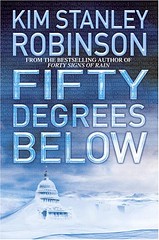Tuesday, July 11, 2006

Title: Fifty Degrees Below
Author: Kim Stanley Robinson
Publisher: Harper Collins
Fifty Degrees Below starts where Kim Stanley Robinson’s previous novel, Forty Signs of Rain, left off, the two fundamentally one novel split in half. This made Forty Signs of Rain feel very much like an unfinished work, and in turn Fifty Degrees Below takes a little time to click into place – waiting for the characters and events to make sense again.
Having resisted acknowledging the dangers of climate change Washington DC has found itself getting first hand experience at the end of Forty Signs of Rain. We start with the after math, train lines still out of action, the high water marks still showing on the front of buildings, the animals from the zoo the survived living wild in the city’s parks. But in Fifty Degrees Below things can only get worse with winter approaching.
Like Forty Signs of Rain, Fifty Degrees Below features periodic cameos by Phil Chase and Wade Newton, linking these two novel back to Robinson’s earlier Antarctica. But again the novel alternates primarily between Frank Vanderwaal and the Quibler family. Charlie Quibler a stay at home father and advisor on environmental matters to presidential candidate Chase, while his wife Anna works for the National Science Foundation.
The way the novel balances out though, this is really Frank’s story – at the end of his year with the NSF he is left frustrated by bureaucracy and inaction. Having said some thing he shouldn’t have, Frank is surprised to be offered a second year, and not only that but offered a chance to put his money where his mouth is. Even if no one else has recognised the immanence of catastrophe, those in charge of the NSF have, and are prepared to try and understand and act. So Frank accepts, but the person he leased his flat from is back in town, and with the recent flooding property is a premium.
This fact and Frank’s increasing discomfort with a modern lifestyle lead him to live rough. Frank dumps his car and gets a van he can sleep in, then sets up a tree house in the ravaged park land, right in amongst the homeless and the zoo’s stray animals. This sets up the novel’s contrast. Much of Fifty Degrees Below is spent on plans to save the world, Robinson launching into his dense environmental writing. But those sections with Frank living wild, meeting the people, really experiencing a raw frontline serve to give a sense of adventure, grit and depth to the dryer material.
Fifty Degrees Below is contradictory, a little strange and ragged. The ending is much more satisfying than that of Forty Signs of Rain, and leaves the reader with a greater sense of conclusion. Though there are still enough elements left unresolved that one does wonder, to some degree, whether there is more to come – there could easily be more with Frank and his mystery woman, his ex-girlfriend, and lets face it the world still needs saving.
Comments:
Post a Comment
 this is the voice of re:mote induction.
this is the voice of re:mote induction.